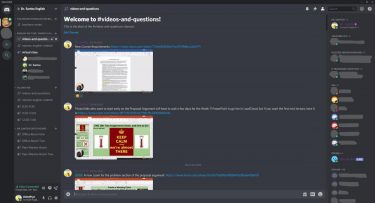
By Mike Kilen
GCU News Bureau
Dr. Jen Santos turned to her Grand Canyon University English class when faced with the news that her courses would go online because of the pandemic.
"How will this work best for you?" she asked them.
That’s when students hatched a unique idea – using a digital platform designed for video gaming communities to communicate in classes remotely.
It doesn’t hurt when your professor is a former gamer. She was game.
“It was really creative thinking and we did it together. If I was to do it myself, I wouldn’t have come up with this idea, so I give them a lot of credit,” said Santos, Associate Professor of English, who used the platform Discord to conduct her English 105 and 106 classes.
It’s one example of how College of Humanities and Social Sciences faculty and students used their ingenuity and resilient spirit to transition classes online and finish the semester amid the COVID-19 crisis.
Some of Santos' students expressed concern over possible internet connectivity and other technical barriers or home distractions, such as taking care of siblings.

Santos, student Bronson Bodlak and others teamed up to execute the Discord plan. Bodlak became the information technology expert on the project, creating time slots on Discord for each of three English courses and adding students to each.
It became a virtual classroom with audio, video and messaging capabilities.
“Discord has been the best for the students because everyone is interacting with the professor and it made the classroom a friendly environment,” said Bodlak, who ended up doing his final essay on the effort. “This was especially effective in that everyone was able to contact each other with simple name commands that got the attention of users with a specific tag.”
Discord also allowed for a classroom of interactions without having to appear on screen during a Zoom session.
“The result is I had people attending class or ask questions while they were at work or caring for siblings, and they didn’t have to be on camera,” Santos said. “One student came to class while fixing a plumbing issue.”
While she sent them recorded Loom videos to review before discussion, the Discord sessions became “a neat exercise in community,” she said.
Student Samantha Gomez, who served as a mentor in the class, said it was easier than other platforms to jump online quickly, and “screen sharing in Discord allowed students to share their documents without face-to-face video calling.”
Santos provided thoughts on the screen shares via audio while students reacted in chat form.
“It was almost like a whiteboard, but they were the ones using it,” Santos said.
“We tried to keep in fun,” she said. “One rule on Discord was to say goodbye before you leave. We understand some can’t stay the whole time. So one of my classes turned that into saying goodbye via a GIF, like SpongeBob waving or a little cat or dog.

“No one wanted to leave because they wanted to see what everyone would post for a GIF that day.”
As Santos spoke on a early afternoon last week, she said there were three students still on the platform interacting from their 9 a.m. class.
“Cracks me up,” she said.
It was a prime example of using many online tools to stay connected.
“We have learned an enormous amount about the pedagogical creativity of our professors,” CHSS Dean Dr. Sherman Elliott said. “Because of their talents and fast-moving adjustments to their classes, the transition for our learners has been smooth and continued to allow learning to take place.”
Other instructors faced a daunting prospect in courses where classroom discussion is a major factor.
“My (statistics) students need me a little more. It’s a class that students have some pretty high anxiety about because the curriculum is tough. They have a lot of questions about it,” said Dr. Julie Nelson, Associate Professor in Psychology.
Plus, some students were going to home environments with economic stress because of the crisis or crowded with both parents and siblings living and working there.
A vital tool for her was Remind, a private mobile messaging platform that allows teachers to communicate with an entire class.

“I really tried to be aware that everyone is under duress, so I always started my communication with hoping that everyone was safe and well,” she said.
“There are ways you can communicate at the beginning of every class to convey your personality and interest in them and really establish relationships. It’s harder to do online, but it’s necessary.”
If students really believe that you care about them and you can go to the extra effort to convey that, they will respond, she said. With the non-verbals of face-to-face communication impossible, the friendly emoji became one of her biggest friends.
Nelson could send text messages for Remind that students could access on browsers or their phones to notify them of future Zoom sessions, to watch a Loom recording or to communicate one on one.
“I can track them down in ways I couldn’t before,” she said. “I think it is important that your messages are upbeat and informational. The cool thing is that nearly every day I am getting messages expressing gratitude.”
Wherever she goes throughout the day, she said, her students’ messages are carried with her on her phone.
While she was talking, she pulled up one of them: “I really appreciate all the hard work you put into ensuring our success. Thanks for this semester and have a great summer.”
Make no mistake, faculty logged extra time on moving classes to a remote environment.
“Admittedly, it was a lot of extra work, but the payoff is big as well,” said Dr. Makisha Gunty, an instructor in Sociology and Social Work.

She made sure that each student could have a private forum to check in with her if need be during weekly remote “office hours.”
And because group work is vital in sociology courses, she set up breakout sessions during Zoom classes.
“It really was lemonade out of lemons,” she said. “It wasn’t magic bullets. I think it’s fair to share that it wasn’t perfect all around, but I think it did help students in the transition.”
Flexibility was key. For example, she offered students the option of recording their presentations or doing them live via Zoom.
“I had a student turn in her video presentation, and she had a dog walk across, she had brothers who came in and out, she had a toddler who tried to hit the computer,” she said. “I could be really strict and say, ‘No, you need to get in a private area and conduct it professionally.’ The reality is she said there were just so many people living in her house, there is not a quiet place. I’m not going to dock her for that. She is making the best of the situation she had.”
The pandemic was a key area of discussion in sociology and social work classes, addressing coping methods, child development, government strategies to social problems, the challenges of poverty and race, and other subjects.
“While I would never ask for a pandemic, it was an opportunity for those learning lessons,” she said.
In her first semester of teaching at GCU, she came away impressed with students' resilience. They didn’t make excuses.
“Several lost jobs – one student was on the wait staff and had to get a job at a supermarket for minimum wage,” she said. “I was impressed they that took responsibility. They didn’t come at me entitled. That warms the cockles of my heart.”
Grand Canyon University senior writer Mike Kilen can be reached at [email protected] or at 602-639-6764.















